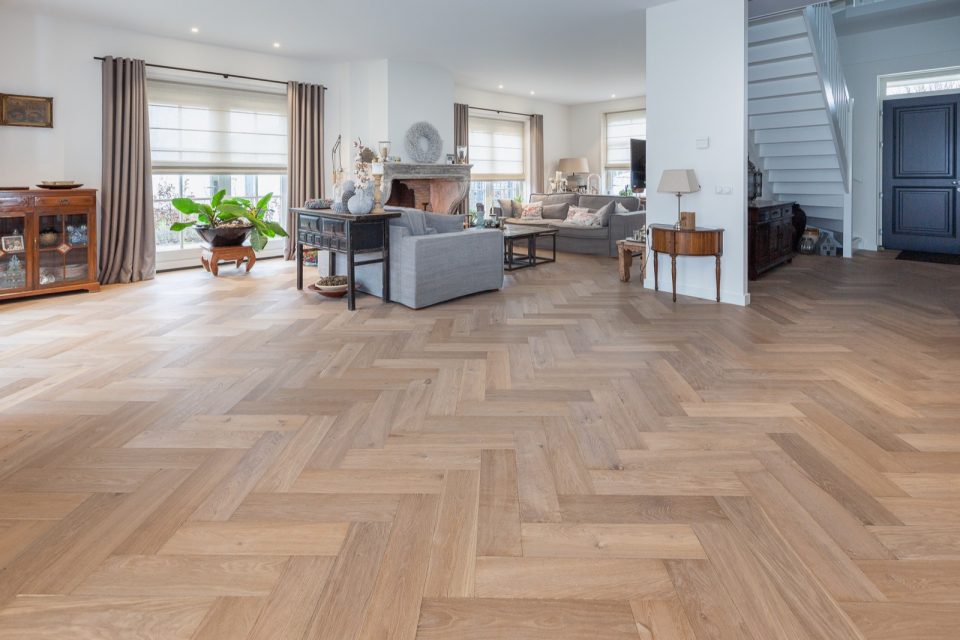Oak flooring, a herringbone pattern or just straight?

Are you hesitating between an oak herringbone floor or a floor with straight planks? This is not strange at all. On the contrary. To arrive at the right choice, Dutzfloors is happy to give you advice.
The topics covered include: the type of home, the atmosphere your home should meet and the prices of both options.
Herringbone floor or straight planks?
Straight plank flooring actually fits any type of home. For a herringbone floor, this is a little more nuanced. But for some homes and styles, herringbone flooring fits better. To make the choice a little easier, we now briefly tell you about them.
An existing or new house
There is quite a difference between a new construction home or a 1930s home. By comparison:
– In a new construction home, a straight plank floor with planks 18, 22 or 26cm wide fits nicely, or a wide herringbone floor; also called a duo plank herringbone floor. Dimensions that fit nicely in a new construction home are: 14 x 56, 16 x 80 and 18 x 90cm. This involves the width x length of the boards.
– In a 1930s home, a straight plank floor of 18 or 22cm wide planks fits nicely or a herringbone floor with narrower planks. The sizes we commonly lay in 1930s homes are: 7 x 35, 9 x 45 and 14 x 56 cm. The narrower courses create an authentic character appropriate for a 1930s home.
If you choose a herringbone floor, it’s nice to give the home a quiet decor, or in other words, not too much furniture and frills.
Family home or an apartment
Laying an oak floor in a family home is very different from one in an apartment. By comparison:
– In a family home where the floor will be in the living room, kitchen and hall, the same floor will look best. This, in fact, creates a calm and spacious feeling. Because the floor is laid through without thresholds, you can choose either a straight floor or a herringbone floor.
– In an apartment, there are several rooms such as the living room, kitchen and bedrooms. If the area per room is 15m2 or more, you can choose herringbone flooring. If these areas are smaller, we recommend choosing a floor with straight planks. After all, you want the herringbone pattern to look nice. This is especially achieved in a larger space.
The amount of square footage and size of the floor
One of the most important points in deciding whether to choose a herringbone floor or a floor with straight planks is the number of square meters. Below is an example:
– Up to 40m2: Is it a newly built house or an apartment? Choose straight plank flooring. Is it a 1930s house? Then choose planks 18 or 22cm wide or a narrow herringbone floor with a maximum dimension of 14 x 56 cm.
– 40m2 to 60m2: If the floor area to be laid is between 40 and 60m2 then we recommend choosing 18 or 22cm wide plank flooring. Then for a herringbone floor with a size of 14 x 56 or 16 x 80cm.
– More than 60 m2: Choose larger sizes, which creates a calm and spacious effect. For straight planks, it is nice to choose 22 or 26cm wide, and for a herringbone floor, 16 x 80 or 18 x 90 cm planks.
Cost of herringbone or straight plank flooring
A herringbone floor is generally more expensive than a straight plank floor. We like to give an example. To keep it simple, we are comparing two exactly the same floors. By this we mean that the oak planks have exactly the same characteristics; only the pattern is different.
If we compare the exact same floors you will pay about €22 more per square meter for a herringbone floor. This is just one example. In fact, there is a wide variety of different straight and herringbone floors. All this with a variety of prices. Sometimes a straight floor is even more costly. Yet if you compare two floors with the same features that differ only in pattern then it means that herringbone flooring has a higher price tag.
View Dutzfloors’ projects here






